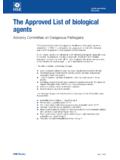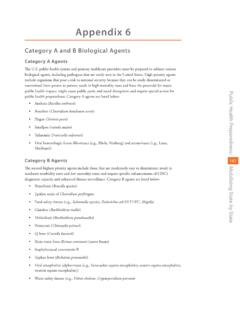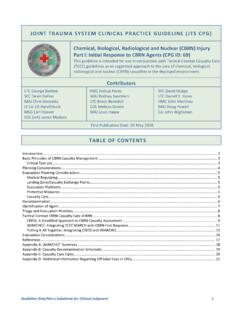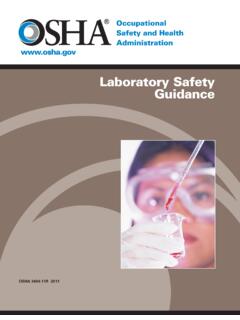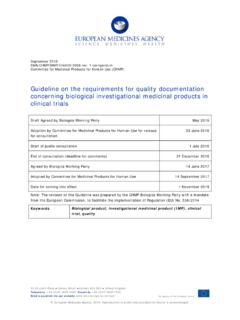Transcription of Biological Control of Plant Pathogens - APS Home
1 Pal, K. K. and B. McSpadden Gardener, 2006. Biological Control of Plant Pathogens . The Plant Health Instructor DOI: Biological Control of Plant Pathogens Kamal Krishna Pal*, Visiting Scholar, Department of Plant Pathology, Ohio State University, OARDC, Wooster, OH. Brian McSpadden Gardener, Department of Plant Pathology, Ohio State University, OARDC, Wooster, OH. *Permanent address: National Research Centre for Groundnut, Ivnagar Road, PB No. 5, Juangadh-362 001, Gujarat, India Introduction Plant diseases need to be controlled to maintain the quality and abundance of food, feed, and fiber produced by growers around the world. Different approaches may be used to prevent, mitigate or Control Plant diseases. Beyond good agronomic and horticultural practices, growers often rely heavily on chemical fertilizers and pesticides. Such inputs to agriculture have contributed significantly to the spectacular improvements in crop productivity and quality over the past 100 years.
2 However, the environmental pollution caused by excessive use and misuse of agrochemicals, as well as fear-mongering by some opponents of pesticides, has led to considerable changes in people's attitudes towards the use of pesticides in agriculture. Today, there are strict regulations on chemical pesticide use, and there is political pressure to remove the most hazardous chemicals from the market. Additionally, the spread of Plant diseases in natural ecosystems may preclude successful application of chemicals, because of the scale to which such applications might have to be applied. Consequently, some pest management researchers have focused their efforts on developing alternative inputs to synthetic chemicals for controlling pests and diseases. Among these alternatives are those referred to as Biological controls. A variety of Biological controls are available for use, but further development and effective adoption will require a greater understanding of the complex interactions among plants , people, and the environment.
3 To that end, this article is presented as an advanced survey of the nature and practice of Biological Control as it is applied to the suppression of Plant diseases. This survey will i) describe the various definitions and key mechanisms of biocontrol, ii) explore the relationships between microbial diversity and Biological Control , iii) describe the current status of research and application of Biological controls, and iv) briefly outline future directions that might lead to the development of more diverse and effective Biological controls for Plant diseases. Definitions The terms Biological Control and its abbreviated synonym biocontrol have been used in different fields of biology, most notably entomology and Plant pathology. In entomology, it has been used to describe the use of live predatory insects, entomopathogenic nematodes, or The Plant Health Instructor, 2006 Biological Control , page 1.
4 Microbial Pathogens to suppress populations of different pest insects. In Plant pathology, the term applies to the use of microbial antagonists to suppress diseases as well as the use of host- specific Pathogens to Control weed populations. In both fields, the organism that suppresses the pest or pathogen is referred to as the Biological Control agent (BCA). More broadly, the term Biological Control also has been applied to the use of the natural products extracted or fermented from various sources. These formulations may be very simple mixtures of natural ingredients with specific activities or complex mixtures with multiple effects on the host as well as the target pest or pathogen. And, while such inputs may mimic the activities of living organisms, non- living inputs should more properly be referred to as biopesticides or biofertilizers, depending on the primary benefit provided to the host Plant .
5 The various definitions offered in the scientific literature have sometimes caused confusion and controversy. For example, members of the National Research Council took into account modern biotechnological developments and referred to Biological Control as the use of natural or modified organisms, genes, or gene products, to reduce the effects of undesirable organisms and to favor desirable organisms such as crops, beneficial insects, and microorganisms , but this definition spurred much subsequent debate and it was frequently considered too broad by many scientists who worked in the field (US Congress, 1995). Because the term Biological Control can refer to a spectrum of ideas, it is important to stipulate the breadth of the term when it is applied to the review of any particular work. Published definitions of biocontrol differ depending on the target of suppression; number, type and source of Biological agents; and the degree and timing of human intervention.
6 Most broadly, Biological Control is the suppression of damaging activities of one organism by one or more other organisms, often referred to as natural enemies. With regards to Plant diseases, suppression can be accomplished in many ways. If growers' activities are considered relevant, cultural practices such as the use of rotations and planting of disease resistant cultivars (whether naturally selected or genetically engineered) would be included in the definition. Because the Plant host responds to numerous Biological factors, both pathogenic and non-pathogenic, induced host resistance might be considered a form of Biological Control . More narrowly, Biological Control refers to the purposeful utilization of introduced or resident living organisms, other than disease resistant host plants , to suppress the activities and populations of one or more Plant Pathogens . This may involve the use of microbial inoculants to suppress a single type or class of Plant diseases.
7 Or, this may involve managing soils to promote the combined activities of native soil- and Plant -associated organisms that contribute to general suppression. Most narrowly, Biological Control refers to the suppression of a single pathogen (or pest), by a single antagonist, in a single cropping system. Most specialists in the field would concur with one of the narrower definitions presented above. In this review, Biological Control will be narrowly defined as highlighted above in bold. Types of interactions contributing to Biological Control Throughout their lifecycle, plants and Pathogens interact with a wide variety of organisms. These interactions can significantly affect Plant health in various ways. In order to understand the mechanisms of Biological Control , it is helpful to appreciate the different ways that organisms interact. Note, too, that in order to interact, organisms must have some form of direct or indirect contact.
8 Odum (1953) proposed that the interactions of two populations be The Plant Health Instructor, 2006 Biological Control , page 2. defined by the outcomes for each. The types of interactions were referred to as mutualism, protocooperation, commensalism, neutralism, competition, amensalism, parasitism, and predation. While the terminology was developed for macroecology, examples of all of these types of interactions can be found in the natural world at both the macroscopic and microscopic level. And, because the development of Plant diseases involves both plants and microbes, the interactions that lead to Biological Control take place at multiple levels of scale. From the Plant 's perspective, Biological Control can be considered a net positive result arising from a variety of specific and non-specific interactions. Using the spectrum of Odum's concepts, we can begin to classify and functionally delineate the diverse components of ecosystems that contribute to biocontrol.
9 Mutualism is an association between two or more species where both species derive benefit. Sometimes, it is an obligatory lifelong interaction involving close physical and biochemical contact, such as those between plants and mycorrhizal fungi. However, they are generally facultative and opportunistic. For example, bacteria in the genus Rhizobium can reproduce either in the soil or, to a much greater degree, through their mutualistic association with legume plants . These types of mutualism can contribute to Biological Control , by fortifying the Plant with improved nutrition and/or by stimulating host defenses. Protocooperation is a form of mutualism, but the organisms involved do not depend exclusively on each other for survival. Many of the microbes isolated and classified as BCAs can be considered facultative mutualists involved in protocooperation, because survival rarely depends on any specific host and disease suppression will vary depending on the prevailing environmental conditions.
10 Further down the spectrum, commensalism is a symbiotic interaction between two living organisms, where one organism benefits and the other is neither harmed nor benefited. Most Plant -associated microbes are assumed to be commensals with regards to the host Plant , because their presence, individually or in total, rarely results in overtly positive or negative consequences to the Plant . And, while their presence may present a variety of challenges to an infecting pathogen, an absence of measurable decrease in pathogen infection or disease severity is indicative of commensal interactions. Neutralism describes the Biological interactions when the population density of one species has absolutely no effect whatsoever on the other. Related to Biological Control , an inability to associate the population dynamics of pathogen with that of another organism would indicate neutralism.

